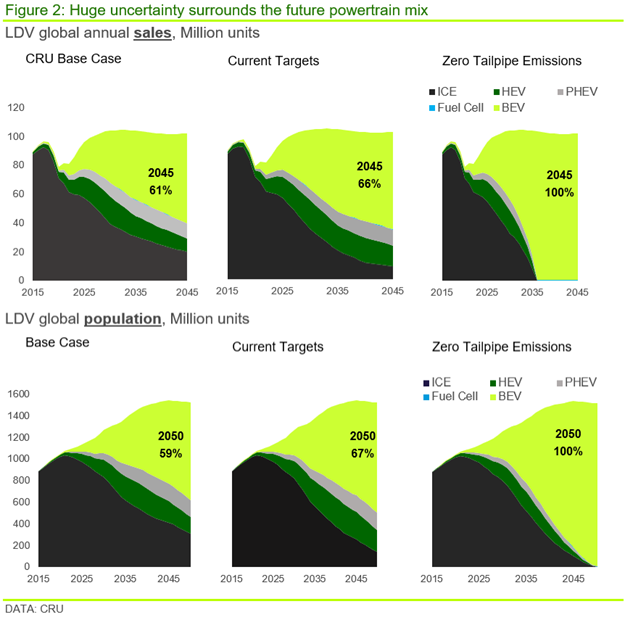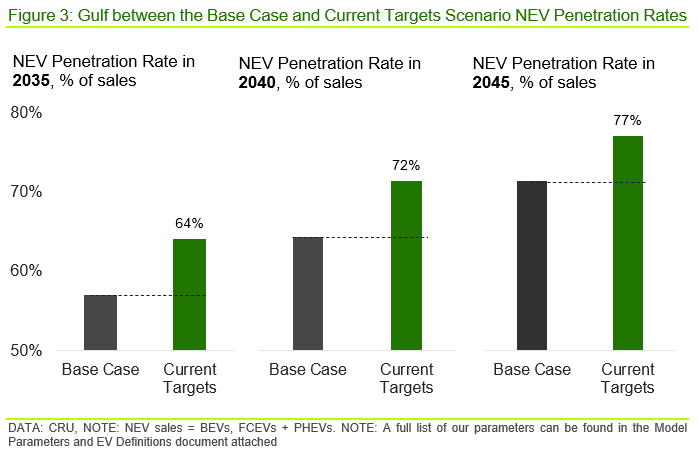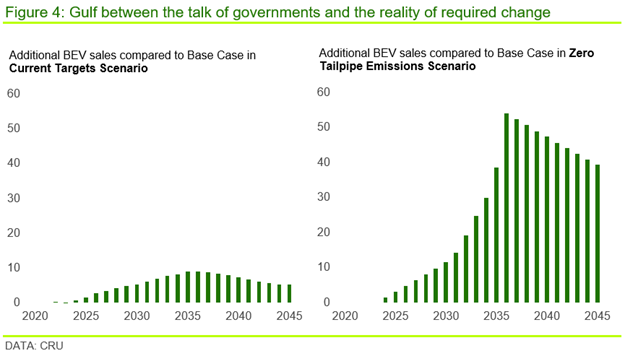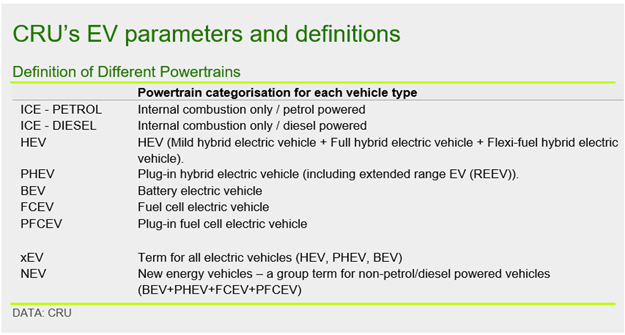Authors: Bethany Emerson, Charlie Durant, Martin Jackson and Arthur Wang
- The threat of global economic recession is hurting the global automotive sector but electric vehicle sales are still beating expectations. CRU has revised up its Base Case long term forecasts for electric vehicles (EV) sales, bringing them closer to current government pledges and targets.
- Yet, a substantial gulf remains between what many governments and corporations are pledging and what we forecast will likely happen, particularly in the 2030s. Policies focused on the light duty vehicle (LDV) sector are becoming more popular at the national level. However, the lack of interim targets, hazy definitions of what constitutes low-emission vehicles, mixed financial support and a need for far greater rollout of infrastructure will hamper EV penetration rates.
- Due to the life expectancy of automotives, if tailpipe emissions from the LDV sector are to end by 2050, in line with various net zero targets, then there is limited time to end sales of new internal combustion engine vehicles (ICE). More dramatic action is needed by governments, even in the short to medium term to enable this.
EV sales ramp up as policy pledges stack up
The threat of global economic recession is hurting the global automotive sector, but electric vehicle sales are still beating expectations, especially in the Chinese market. This year, one in every four vehicles sold in China will be either a full battery electric vehicle (BEV) or a plug-in hybrid vehicle (PHEV). Through 2022, the passing of the Inflation Reduction Act in the US, continued rapid growth in China, as well as legally binding targets in large markets such as the EU and California have boosted the outlook for EV markets. As such, CRU has revised up its Base Case long term forecasts for electric vehicles sales, bringing them closer to current government pledges and targets.
Over the last year many governments have introduced policies aimed at reducing emissions from the LDV sector. An increasing number of governments are now looking to ban sales of new ICEs and hybrid vehicles (HEV), and in some cases PHEVs, by 2035. Many governments have pledged to hit net zero emissions by 2050, which requires halting new sales of emitting vehicles far ahead of this.
At COP26 in Q4 2021, the transport sector was one of the central thematic discussions. The Zero Emission Vehicles (ZEV) Declaration was launched. This has been signed by ~40 national governments, as well as various non-state actors. Signatories pledged to “work towards all sales of new cars and vans being zero emission globally by 2040, and by no later than 2035 in leading markets.”
While the transport sector was not as thematically important at COP27, the conference did see the launch of the Accelerating to Zero Coalition. This is “a platform for leading initiatives to work together to deliver a Paris-aligned Zero Emission Vehicle (ZEV) transition globally.”
The ZEV Declaration has helped increase the global coverage of pledges on how to decarbonise the LDV sector. However, the declaration lacks interim targets and is not legally binding for signatories. Moreover, the governments of some of the largest car markets such as the US, China, Germany and Japan are not signatories. Since this announcement, many signatories have launched policies that go beyond the aims of the declaration.
More policies being launched in major markets
In the EU, the European Parliament and member states agreed in mid-October to back the European Commission’s proposal to ban the sale of new petrol and diesel cars and vans from 2035. The ban includes HEV and PHEVs. From 2035, all new cars sold on the EU market will need to be zero-emission. CRU forecasts this will mean that only full battery electric vehicles are sold in the bloc. There are also interim targets citing a 55% reduction in emissions from new petrol and diesel cars by 2030 compared to 2021 levels.
In the US, EV targets are increasingly being driven at the state level. In August 2022, California banned the sale of new ICE vehicles from 2035. Other states, such as New York, have adopted the rules, with ~15 other states also examining enacting policies in line with the Clean Air Act waiver.
China has not updated its initial policies over the last year. However, it has already outperformed its interim targets for 2025 and remains on track to vastly surpass its 2030 targets. CRU’s Base Case forecast sees Chinese new energy vehicle sales, a collective term for BEVs and PHEVs, abbreviated to NEV, at way over 50% of total sales in 2030. Fuel cell electric vehicles also fall into the NEV category, but we do not expect this technology type to gain market share in LDV markets.

Despite strong EV sales, policy targets remain out of reach
Electric vehicle markets are changing fast and there is a huge degree of uncertainty about the path they may take. In this section we compare our base case forecast with two policy scenarios. The section shows that there remains a gulf between the most likely outcome and the structural change needed in these markets:
- Base Case – This is our base case forecast for the powertrain mix in LDV markets. We quantify the gap between this and what would be required in the two scenarios below.
- Current Targets Scenario - What would EV penetration rates look like if all current global government targets were hit? This scenario models what would happen if current both binding and non-binding targets are achieved.
- Zero Tailpipe Emissions Scenario – This scenario examines the numbers behind net zero targets. Here we ask what the light vehicle market would look like if only vehicles with zero tailpipe emissions, direct automotive emissions from combustion of gasoline and diesel, were on the road in 2050? In CRU’s models, we forecast an extremely low penetration rate of fuel cell vehicles into LDV markets.
CRU attaches a low possibility to the Zero Tailpipe Emissions Scenario being met. However, it is useful in demonstrating the potential upside risks to the Base Case forecast and, at the same time, showing the gulf between the rhetoric and non-binding targets, and the current direction of travel.

Electric vehicle markets still accelerating
Globally, updates to the CRU Base Case mean that the gulf between the Base Case and the Current Targets Scenarios is now narrower in the 2040s than previously forecast. CRU’s Base Case is more aligned with the current policy targets than it was six months ago. Yet there remain substantial differences between the two scenarios. To achieve policy aims, the widespread adoption of EVs in the place of ICEs is needed. Despite the increased support of national policies, the pathways to hitting such targets remain unclear.
Many pledges and policy announcements covering the LDV sector lack detail about how they will be achieved. Many lack interim targets, have hazy definitions of what constitutes low-emission vehicles, lack the financial or infrastructure support needed to enable EV markets to grow as rapidly as their stated aims require.
Under the Current Targets Scenario, the early to mid-2020s represent an “inflection point” for EV sales. However, the lack of interim policies or legally binding bans reduces the likelihood that such a substantial increase in EV sales can be achieved within the next decade.
The legally backed bans that exist also see significant variation. Some policies have a hard ban on emitting vehicles, such as in the EU, while many definitions of zero/low emissions vehicles can include HEV or PHEV vehicles. Japan’s ban excludes both HEV and PHEVs. In Canada, the ban allows for vehicles with the potential to produce no tailpipe emissions, thus allowing internal combustion engines if the car can operate without its continuous use. In California, the ban stipulates that internal combustion engine may be used if the car can run at least 50 miles exclusively on battery power.
For governments and OEMs to achieve their aims, either stronger national policies, accompanied by interim goals and specified pathways, or stronger supra-national agreements, encompassing a larger share of the global car markets, are required.

Large disparity between net zero and current trajectory
If governments are to hit net-zero targets, policy aims must be accompanied by both stringent interim targets and comprehensive net-zero definitions.
To meet the Zero Tailpipe Emissions Scenario by 2050, all new LDV sales from 2035 will need to be full battery electric vehicles or fuel cell vehicles, assuming a blanket fifteen-year life expectancy for LDVs. We assume that BEVs will be the vastly dominant technology, with only an extremely limited fuel cell penetration into LDV markets.
With a rough 15-year life expectancy, ICE, HEVs or PHEVs sold in the late 2030s or 2040s would still be emitting by 2050. Path dependence is a key issue when modelling technology adoption rates. Due to the life expectancy of automotives, if tailpipe emissions from the LDV sector are to end by 2050, then there is limited time to end sales of emitting vehicles. More dramatic action is needed by governments, even in the short to medium term, to enable this.
Mind the gap

CRU’s Base Case is more aligned with the current policy targets than it was six months ago. Yet, our scenarios show that EV penetration rates need to accelerate very rapidly to hit current policies and pledges. Particularly, if tail pipe emissions were to be eliminated by 2050.
Over the last year there has been an increased focus on national EV policies. For current policy targets to alter the global EV trajectory, or to help eliminate tail pipe emissions from the LDV sector by 2050, more policies must be legally binding, accompanied by in-depth pathways that include interim targets.
Without them, many policies and pledges appear more aspirational than realistic.

To discuss this insight or battery materials further please contact: charlie.durant@crugoup.com, arthur.wang@crugroup.com or martin.jackson@crugroup.com
Find out more about our Sustainability Services.
Our reputation as an independent and impartial authority means you can rely on our data and insights to answer your big sustainability questions.
Tell me more



